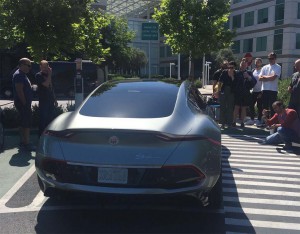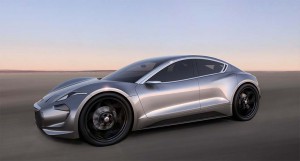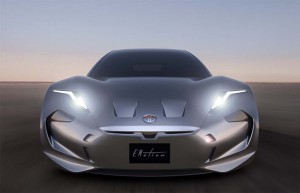
A Fisker Emotion was spotted at Apple HQ in Silicon Valley. Could the tech firm be interested in using the EV as a platform for its autonomous system?
Is Henrik Fisker hoping to take a bit out of the Apple? Or, more accurately, is Apple interested in getting a taste of the Danish designer’s new Emotion battery-electric vehicle?
After long refusing to comment about its rumored plans to develop an autonomous vehicle, Apple is finally lifting the kimono, CEO Tim Cook recently describing that effort as “the mother of all AI projects.” But Apple reportedly shut down its own vehicle development program last year and apparently is looking for partners to work with on the hardware side.
It is teaming up with Hertz to lease a handful of Lexus RX utility vehicles, media reports revealed this week. But longer-term? Apple was apparently looking at building its own battery-car before pulling the plug on that side of the project, so it eventually will need a partner to put its autonomous technology onto the road.
(Why is Waymo teaming up with Avis and Apple with Hertz? Click Here to find out.)
Henrik Fisker, you may recall, is a Danish designer originally known for striking projects like the Aston Martin DB9. He struck out on his own and wound up, in 2011, rolling out a plug-in hybrid dubbed the Fisker Karma. But its karma was anything but good, the company running into a series of obstacles before declaring bankruptcy, its assets sold off to the Chinese Wanxiang Group.
(Wanxiang renamed Fisker Automotive Karma Automotive and the plug-in hybrid, now known as the Revero, recently went back into low-volume production.)
After licking his wounds, Fisker is back. He’s started a new company and rolled out a new product that, this time, is 100% electric. But instead of using conventional batteries, the new Emotion apparently blends batteries and ultracapacitors using a Nobel Prize-winning compound known as graphene.
According to the Danish entrepreneur, this approach provides significant advantages – the Fisker Emotion said to get 400 miles per charge, while also recharging more quickly than regular batteries.
While Fisker has provided a number of static shots, his new company apparently has at least one model rolling around California. And it was spotted outside Apple’s Silicon Valley headquarters, a copy of this shot first appearing in Germany’s Auto Motor und Sport before reaching us through sources.
The likelihood of a sightseeing tour is slight. And while Henrik Fisker declined to comment – with Apple not yet responding to a request for comment – some of those sources say the Emotion was there for some very practical, rather than emotional, reasons.
Members of the Apple development team apparently wanted a closer look at the Emotion, and a better understanding of its unusual driveline technology, so they asked the Fisker crew to bring one up from that company’s headquarters in Southern California.
We’ve not been able to confirm whether the Emotion was trucked the roughly 400-mile distance or actually drove the entire way. And those sources wouldn’t say whether anyone from Apple actually drove in the electric vehicle. What’s clear is that it was an early contact and that additional conversations would be necessary before any tie-up between the two companies.
Texted one of those involved, “Advanced tech and amazing Fisker design.”
The design, incidentally, clearly harkens back to the original Fisker Karma. It’s a bit smoother and grille-less, much like the Tesla Model S and newer Model 3. Aerodynamics clearly play a role in both sports car design and in the styling of an electric vehicle, especially one that Fisker promises wlll top out at 161 mph.
Along with wind-cheating features like its low nose and an integrated spoiler, the Fisker Emotion will get a sealed underbody. But the most visually distinctive touch is likely to be the use of dihedral doors. The approach could prove technically challenging, as Tesla has learned with the “falcon doors” on its Model X. But there already have been production vehicles with more common, if still exotic butterfly doors.
(BMW expected to reveal new 3-Series EV at Frankfurt Motor Show. Click Here for the story.)
On the technology side, expect to see adaptive headlights, an up-to-date infotainment system, a wide range of high-tech safety features and full autonomous capability. That will be purchased, Fisker said, from a “soon-to-be-announced supplier.” There are several, including German-based Continental Teves, and perhaps even Google, whom Fisker might be talking with.
As for timing, the plan is to roll out the Fisker Emotion later in 2017, the start-up looking to an “existing facility” in California. Where that might be is uncertain. Indeed, since the initial vehicle is expected to be produced in low volume, might it come out of a non-automotive plant?
Longer-term, Henrik Fisker recently told TheDetroitBureau.com that his new company wants to lift a page from the Tesla handbook. That would have it launch production with an expensive, high-performance halo car but eventually add more affordable products to its line-up.
There are plenty of skeptics, of course, especially in light of the spectacular meltdown of Fisker Automotive. But if the new company really has the sort of breakthrough power source it claims that could make all the difference. All the more so, if Apple were to seek a tie-up.
If anything did happen, the deep-pocket tech giant might just want a few Emotion sports sedans to use for testing out its autonomous technology. Or it could see Fisker as a way to get into production with a breakthrough product that could let it leapfrog other automakers, whether established companies like General Motors, or newcomers like Tesla.
(Aston Martin scales back plans for RapidE, but is developing electric SUV. Click Here for the story.)


